Effects of Manipulating Fibroblast Growth Factor Expression on Sindbis Virus Replication In Vitro and in Aedes aegypti Mosquitoes
Abstract
1. Introduction
2. Methods
2.1. Cell Culture
2.2. Insects
2.3. Quantitative RT-PCR
2.4. Transient Gene Silencing in Aag2 Cells and Mosquitoes
2.5. Purification of vFGF and Transmigration Experiments
2.6. Recombinant SINV Construction
2.7. Viral RNA Transfection, Virus Infection, and Viral Growth Curves Analyses
2.8. Plaque Purification
2.9. Immunoblotting
2.10. Caspase Activity Assays
2.11. Cell Viability Assays
2.12. DNA Fragmentation Assays
2.13. Oral Infection of Mosquitoes
2.14. Detection of Viral Antigen in Mosquito Midguts
2.15. TCID50 Assay with SINV-Infected Mosquito Samples
3. Results
3.1. Role of Endogenous AeFGF and AeFGFR in SINV Infection
3.2. Stimulation of Mosquito Cell Motility by vFGF
3.3. Generation of Recombinant SINV Expressing vFGF
3.4. Viral Growth Curve Analyses
3.5. Effects of vFGF Expression on Caspase Activity in SINV-Infected C6/36 and Aag2 Cells
3.6. Effect of vFGF Expression on Mosquito Midgut Infection
3.7. Effect of vFGF Expression on SINV Dissemination in Mosquitoes
4. Discussion
Supplementary Materials
Author Contributions
Funding
Acknowledgments
Conflicts of Interest
Ethical statement
References
- Ornitz, D.M.; Itoh, N. Fibroblast growth factors. Genome Biol. 2001, 2, 1–12. [Google Scholar] [CrossRef]
- Sutherland, D.; Samakovlis, C.; Krasnow, M.A. Branchless encodes a Drosophila FGF homolog that controls tracheal cell migration and the pattern of branching. Cell 1996, 87, 1091–1101. [Google Scholar] [CrossRef]
- Means, J.C.; Passarelli, A.L. Viral fibroblast growth factor, matrix metalloproteases, and caspases are associated with enhancing infection by baculoviruses. Proc. Natl. Acad. Sci. USA 2010, 107, 9825–9830. [Google Scholar] [CrossRef] [PubMed]
- Detvisitsakun, C.; Berretta, M.F.; Lehiy, C.; Passarelli, A.L. Stimulation of cell motility by a viral fibroblast growth factor homolog: Proposal for a role in viral pathogenesis. Virology 2005, 336, 308–317. [Google Scholar] [CrossRef] [PubMed]
- Katsuma, S.; Daimon, T.; Mita, K.; Shimada, T. Lepidopteran ortholog of Drosophila Breathless is a receptor for the baculovirus fibroblast growth factor. J. Virol. 2006, 80, 5474–5481. [Google Scholar] [CrossRef]
- Katsuma, S.; Daimon, T.; Horie, S.; Kobyashi, M.; Shimada, T. N-linked glycans of Bombyx mori nucleopolyhedrovirus fibroblast growth factor are crucial for its secretion. Biochem. Biophys. Res. Commun. 2006, 350, 1069–1075. [Google Scholar] [CrossRef]
- Lehiy, C.; Martinez, O.; Passarelli, A.L. Virion-associated viral fibroblast growth factor stimulates cell motility. Virology 2009, 395, 152–160. [Google Scholar] [CrossRef]
- Detvisitsakun, C.; Hutfless, E.L.; Berretta, M.F.; Passarelli, A.L. Analysis of a baculovirus lacking a functional viral fibroblast growth factor homolog. Virology 2006, 346, 258–265. [Google Scholar] [CrossRef]
- Detvisitsakun, C.; Cain, E.L.; Passarelli, A.L. The Autographa californica M nucleopolyhedrovirus fibroblast growth factor accelerates host mortality. Virology 2007, 365, 70–78. [Google Scholar] [CrossRef]
- Katsuma, S.; Horie, S.; Daimon, T.; Iwanaga, M.; Shimada, T. In vivo and in vitro analyses of a Bombyx mori nucleopolyhedrovirus mutant lacking functional vfgf. Virology 2006, 355, 62–70. [Google Scholar] [CrossRef]
- Katsuma, S.; Horie, S.; Shimada, T. The fibroblast growth factor homolog of Bombyx mori nucleopolyhedrovirus enhances systemic propagation in B. mori larvae. Virus Res. 2008, 137, 80–85. [Google Scholar] [CrossRef] [PubMed]
- Means, J.C.; Passarelli, A.L. Intrahaemocoelic infection of Trichoplusia ni with the baculovirus Autographa californica M nucleopolyhedrovirus does not induce tracheal cell basal lamina remodelling. J. Gen. Virol. 2014, 95, 719–723. [Google Scholar] [CrossRef] [PubMed]
- Bennett, K.E.; Beaty, B.J.; Black, W.C.t. Selection of D2S3, an Aedes aegypti (Diptera: Culicidae) strain with high oral susceptibility to Dengue 2 virus and D2MEB, a strain with a midgut barrier to Dengue 2 escape. J. Med. Entomol. 2005, 42, 110–119. [Google Scholar] [CrossRef]
- Black, W.C., IV; Bennett, K.; Gorrochotegui-Escalante, N.; Barillas-Mury, C.; Fernandez-Salas, I.; de Lourdes Munoz, M.; Farfan-Ale, J.A.; Olson, K.E.; Beaty, B.J. Flavivirus susceptibility in Aedes aegypti. Arch. Med. Res. 2002, 33, 379–388. [Google Scholar] [CrossRef]
- Kramer, L.D.; Hardy, J.L.; Presser, S.B.; Houk, E.J. Dissemination barriers for western equine encephalomyelitis virus in Culex tarsalis infected after ingestion of low viral doses. Am. J. Trop. Med. Hyg. 1981, 30, 190–197. [Google Scholar] [CrossRef]
- Houk, E.J.; Hardy, J.L.; Chiles, R.E. Permeability of the midgut basal lamina in the mosquito, Culex tarsalis Coquillett (Insecta, Diptera). Acta Trop. 1981, 38, 163–171. [Google Scholar]
- Dong, S.; Balaraman, V.; Kantor, A.M.; Lyn, J.; Grant, D.G.; Held, N.L.; Franz, A.W.E. Chikungunya virus dissemination from the midgut of Aedes aegypti is associated with temporal basal lamina degradation during bloodmeal digestion. PLoS Negl. Trop. Dis. 2017, 11, e0005976. [Google Scholar] [CrossRef]
- Cui, Y.; Grant, D.G.; Lin, J.; Yu, X.; Franz, A.W.E. Zika virus dissemination from the midgut of Aedes aegypti is facilitated by bloodmeal-mediated structural modification of the midgut basal lamina. Viruses 2019, 11, 1056. [Google Scholar] [CrossRef]
- Armstrong, P.M.; Ehrlich, H.Y.; Magalhaes, T.; Miller, M.R.; Conway, P.J.; Bransfield, A.; Misencik, M.J.; Gloria-Soria, A.; Warren, J.L.; Andreadis, T.G.; et al. Successive blood meals enhance virus dissemination within mosquitoes and increase transmission potential. Nat. Microbiol. 2020, 5, 239–247. [Google Scholar] [CrossRef]
- Cheng, L.L.; Bartholomay, L.C.; Olson, K.E.; Lowenberger, C.; Vizioli, J.; Higgs, S.; Beaty, B.J.; Christensen, B.M. Characterization of an endogenous gene expressed in Aedes aegypti using an orally infectious recombinant Sindbis virus. J. Insect Sci. 2001, 1, 5. [Google Scholar] [CrossRef][Green Version]
- de Lara Capurro, M.; Coleman, J.; Beerntsen, B.T.; Myles, K.M.; Olson, K.E.; Rocha, E.; Krettli, A.U.; James, A.A. Virus-expressed, recombinant single-chain antibody blocks sporozoite infection of salivary glands in Plasmodium gallinaceum-infected Aedes aegypti. Am. J. Trop. Med. Hyg. 2000, 62, 427–433. [Google Scholar] [CrossRef]
- Higgs, S.; Olson, K.E.; Klimowshi, L.; Powers, A.M.; Carlson, J.O.; Posee, R.D.; Beaty, B.J. Mosquito sensitivity to a scorpion neurotoxin expressed using an infectious Sindbis virus vector. Insect Mol. Biol. 1995, 4, 97–103. [Google Scholar] [CrossRef] [PubMed]
- Olson, K.E.; Higgs, S.; Hahn, C.S.; Carlson, J.O.; Beaty, B.J. The expression of chloramphenicol acetyltransferaes in Ae. albopictus (C6/36) cells and Ae. triseriatus mosquitoes using a double subgenomic recombinant Sindbis virus. Insect Biochem. Mol. Biol. 1994, 24, 39–48. [Google Scholar]
- Pierro, D.J.; Myles, K.M.; Foy, B.D.; Beaty, B.J.; Olson, K.E. Development of an orally infectious Sindbis virus transducing system that efficiently disseminates and expresses green fluorescent protein in Aedes aegypti. Insect Mol. Biol. 2003, 12, 107–116. [Google Scholar] [CrossRef]
- Wang, H.; Blair, C.D.; Olson, K.E.; Clem, R.J. Effects of inducing or inhibiting apoptosis on Sindbis virus replication in mosquito cells. J. Gen. Virol. 2008, 89, 2651–2661. [Google Scholar] [CrossRef]
- Wang, H.; Gort, T.; Boyle, D.L.; Clem, R.J. Effects of manipulating apoptosis on Sindbis virus infection of Aedes aegypti mosquitoes. J. Virol. 2012, 86, 6546–6554. [Google Scholar] [CrossRef] [PubMed]
- Wang, H.; Clem, R.J. The role of IAP antagonist proteins in the core apoptosis pathway of the mosquito disease vector Aedes aegypti. Apoptosis 2011, 16, 235–248. [Google Scholar] [CrossRef] [PubMed]
- Hahn, C.S.; Hahn, Y.S.; Braciale, T.J.; Rice, C.M. Infectious Sindbis virus transient expression vectors for studying antigen processing and presentation. Proc. Natl. Acad. Sci. USA 1992, 89, 2679–2683. [Google Scholar] [CrossRef]
- Lustig, S.; Jackson, A.C.; Hahn, C.S.; Griffin, D.E.; Strauss, E.G.; Strauss, J.H. Molecular basis of Sindbis virus neurovirulence in mice. J. Virol. 1988, 62, 2329–2336. [Google Scholar] [CrossRef]
- Foy, B.D.; Myles, K.M.; Pierro, D.J.; Sanchez-Vargas, I.; Uhlirova, M.; Jindra, M.; Beaty, B.J.; Olson, K.E. Development of a new Sindbis virus transducing system and its characterization in three Culicine mosquitoes and two lepidopteran species. Insect Mol. Biol. 2004, 13, 89–100. [Google Scholar] [CrossRef]
- Myles, K.M.; Pierro, D.J.; Olson, K.E. Comparison of the transmission potential of two genetically distinct Sindbis viruses after oral infection of Aedes aegypti (Diptera: Culicidae). J. Med. Entomol. 2004, 41, 95–106. [Google Scholar] [CrossRef] [PubMed]
- Vaughn, J.L.; Goodwin, R.H.; Tompkins, G.J.; McCawley, P. The establishment of two cell lines from the insect Spodoptera frugiperda (Lepidoptera: Noctuidae). In Vitro 1977, 13, 213–217. [Google Scholar] [CrossRef] [PubMed]
- Schmittgen, T.D.; Livak, K.J. Analyzing real-time PCR data by the comparative C(T) method. Nat. Protoc. 2008, 3, 1101–1108. [Google Scholar] [CrossRef] [PubMed]
- Liu, Q.; Clem, R.J. Defining the core apoptosis pathway in the mosquito disease vector Aedes aegypti the roles of iap1, ark, dronc, and effector caspases. Apoptosis 2011, 16, 105–113. [Google Scholar] [CrossRef]
- Crouch, E.A.; Passarelli, A.L. Genetic requirements for homologous recombination in Autographa californica nucleopolyhedrovirus. J. Virol. 2002, 76, 9323–9334. [Google Scholar] [CrossRef][Green Version]
- O’Reilly, D.R.; Miller, L.K.; Luckow, V.A. Baculovirus Expression Vectors: A Laboratory Manual; W. H. Freeman and Company: New York, NY, USA, 1994. [Google Scholar]
- Foy, B.D.; Olson, K.E. Alphavirus transducing systems. Adv. Exp. Med. Biol. 2008, 627, 19–34. [Google Scholar]
- Olson, K.E.; Myles, K.M.; Seabaugh, R.C.; Higgs, S.; Carlson, J.O.; Beaty, B.J. Development of a Sindbis virus expression system that efficiently expresses green fluorescent protein in midguts of Aedes aegypti following per os infection. Insect Mol. Biol. 2000, 9, 57–65. [Google Scholar] [CrossRef]
- Dong, S.; Kantor, A.M.; Lin, J.; Passarelli, A.L.; Clem, R.J.; Franz, A.W. Infection pattern and transmission potential of chikungunya virus in two New World laboratory-adapted Aedes aegypti strains. Sci. Rep. 2016, 6, 1–13. [Google Scholar] [CrossRef]
- Chanas, A.C.; Gould, E.A.; Clegg, J.C.; Varma, M.G. Monoclonal antibodies to Sindbis virus glycoprotein E1 can neutralize, enhance infectivity, and independently inhibit haemagglutination or haemolysis. J. Gen. Virol. 1982, 1, 37–46. [Google Scholar] [CrossRef]
- Ori, A.; Wilkinson, M.C.; Fernig, D.G. The heparanome and regulation of cell function: Structures, functions and challenges. Front. Biosci. 2008, 13, 4309–4338. [Google Scholar] [CrossRef]
- Yayon, A.; Klagsbrun, M.; Esko, J.D.; Leder, P.; Ornitz, D.M. Cell surface, heparin-like molecules are required for binding of basic fibroblast growth factor to its high affinity receptor. Cell 1991, 64, 841–848. [Google Scholar] [CrossRef]

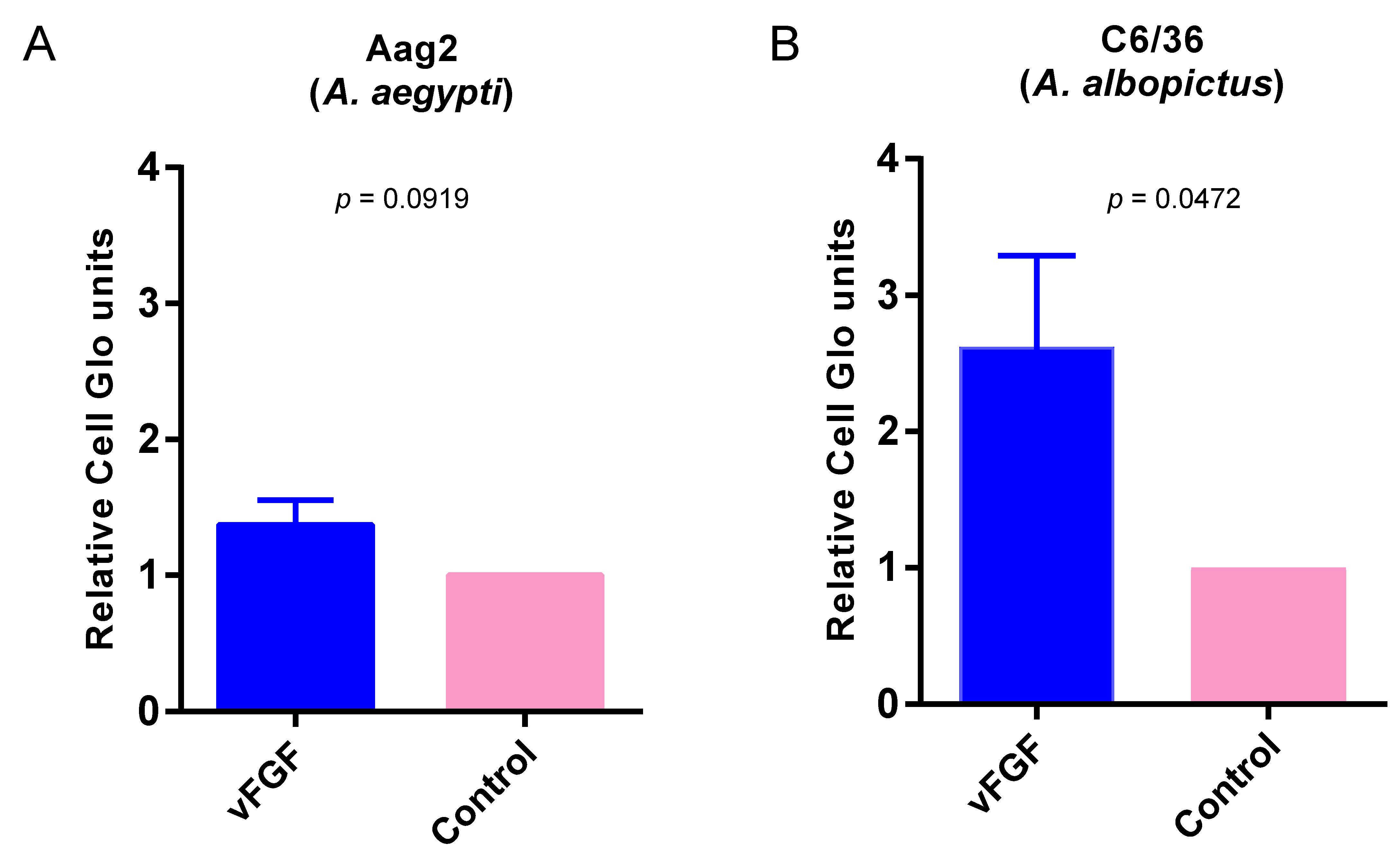
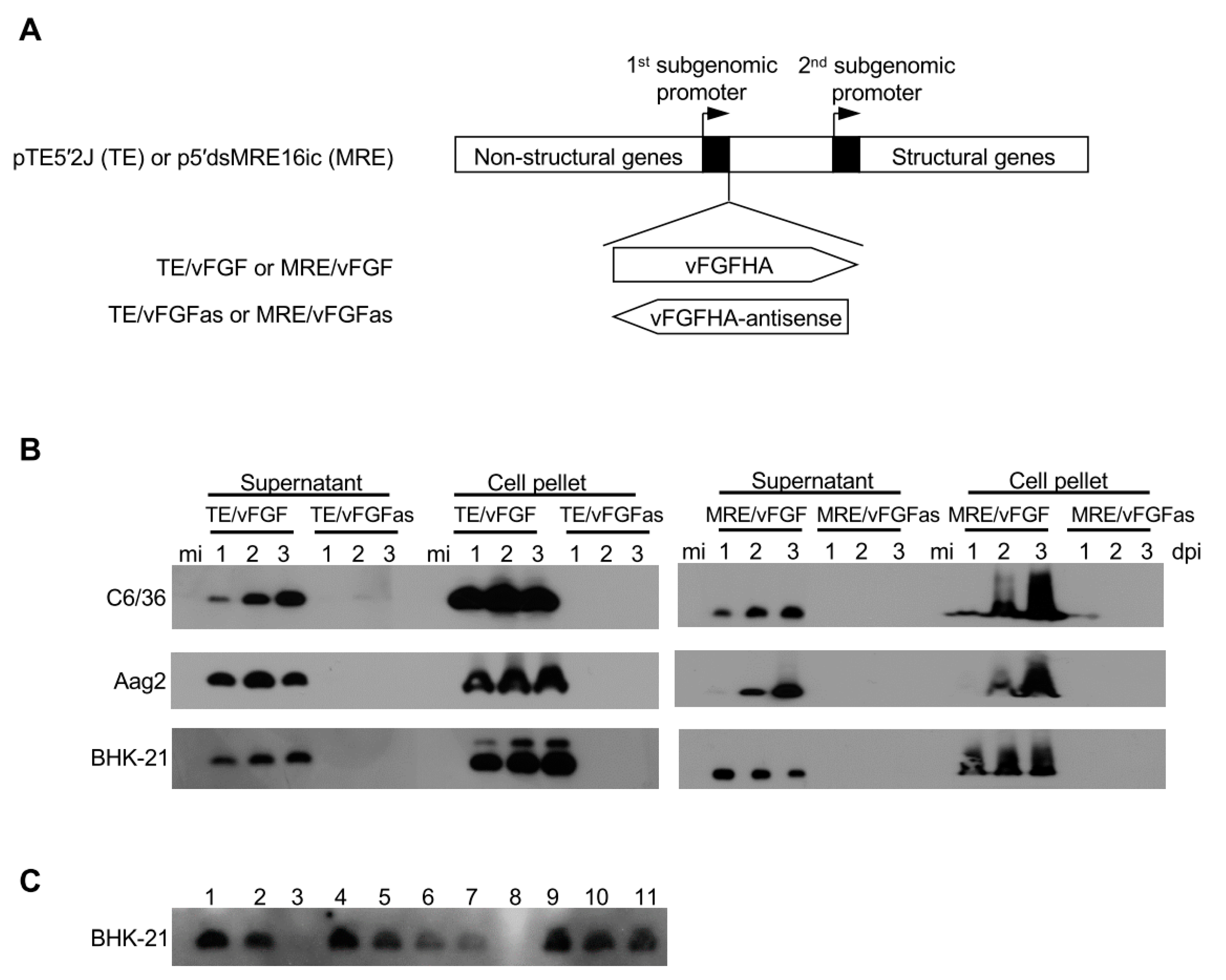
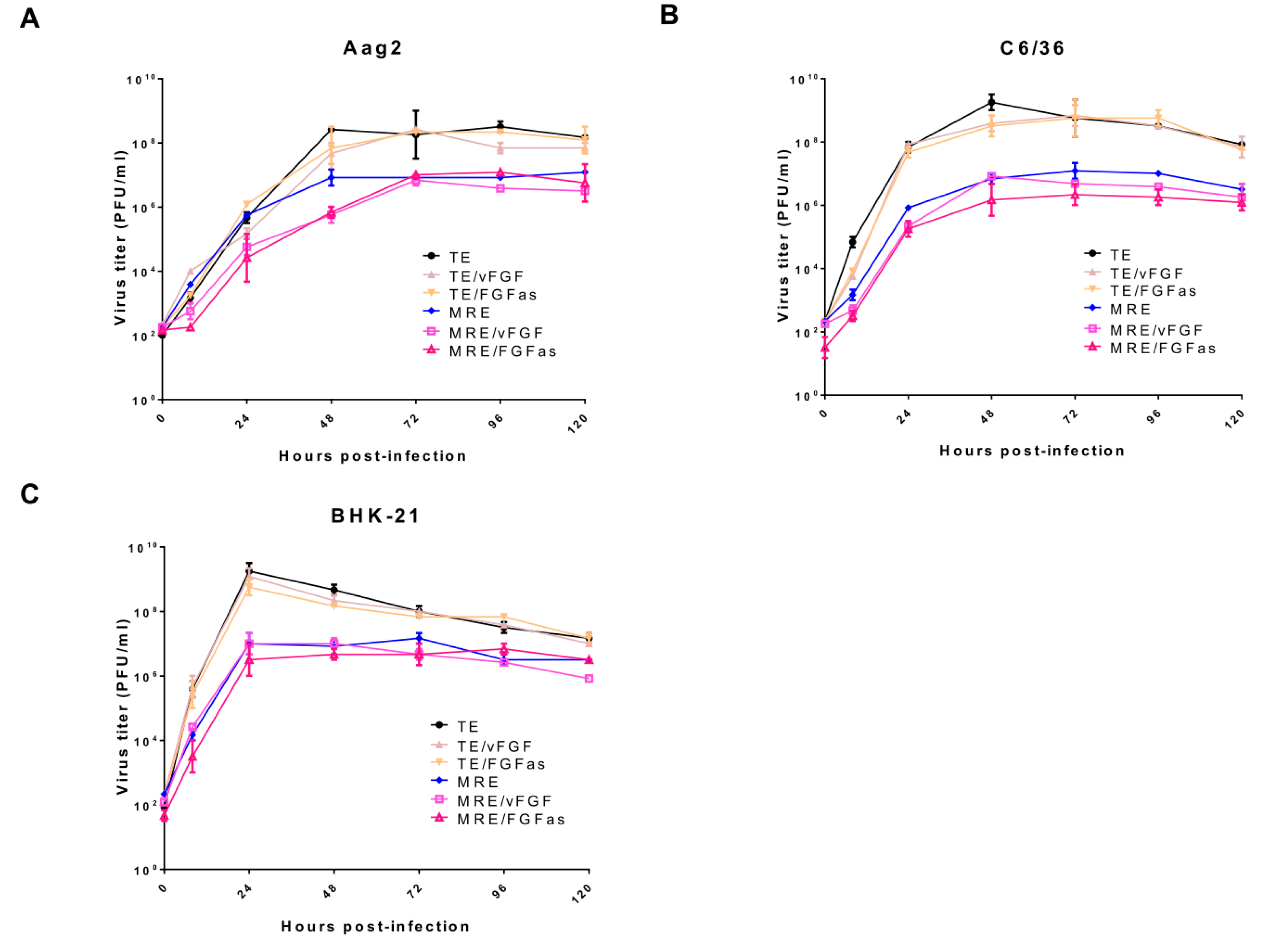
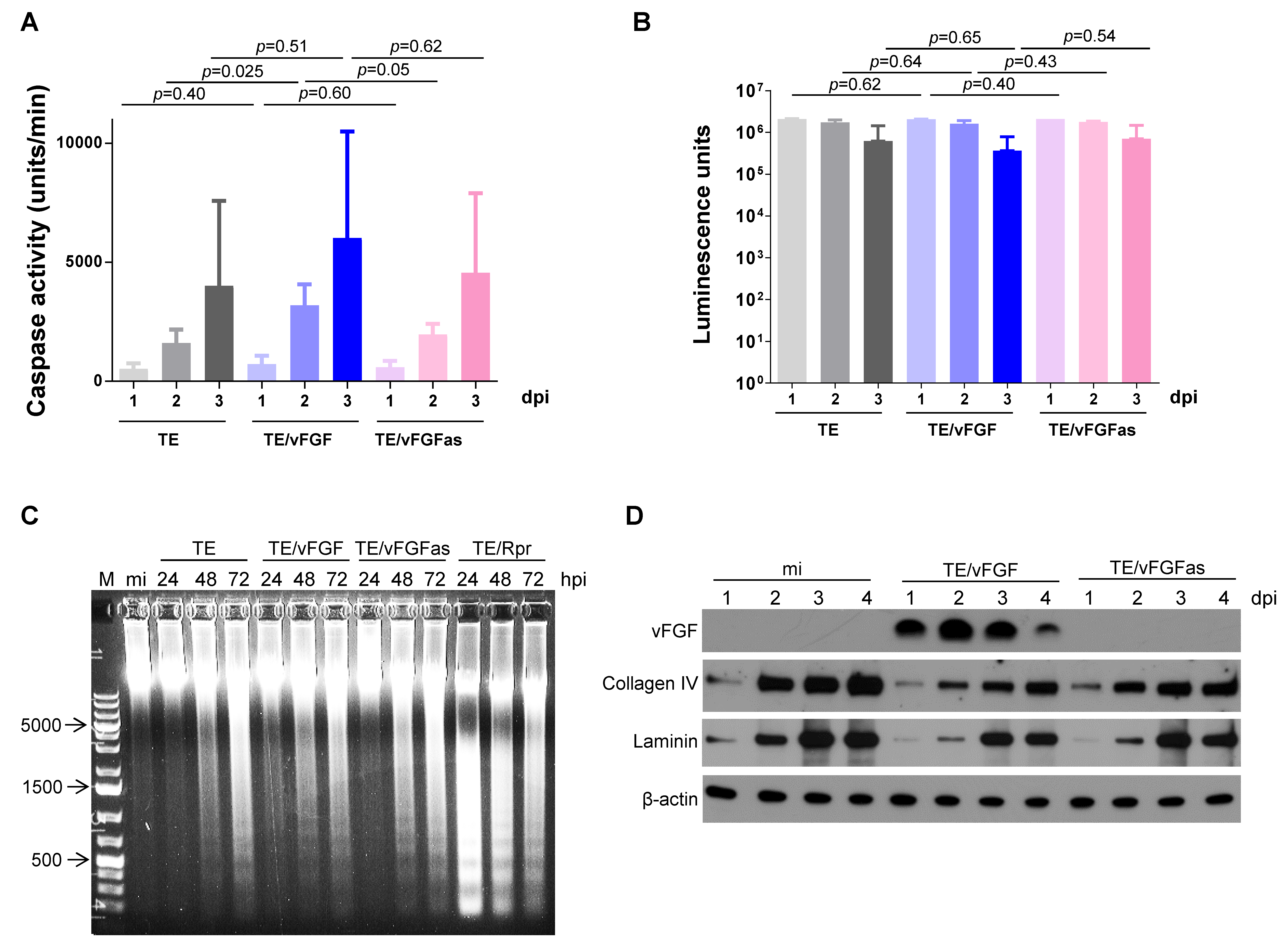
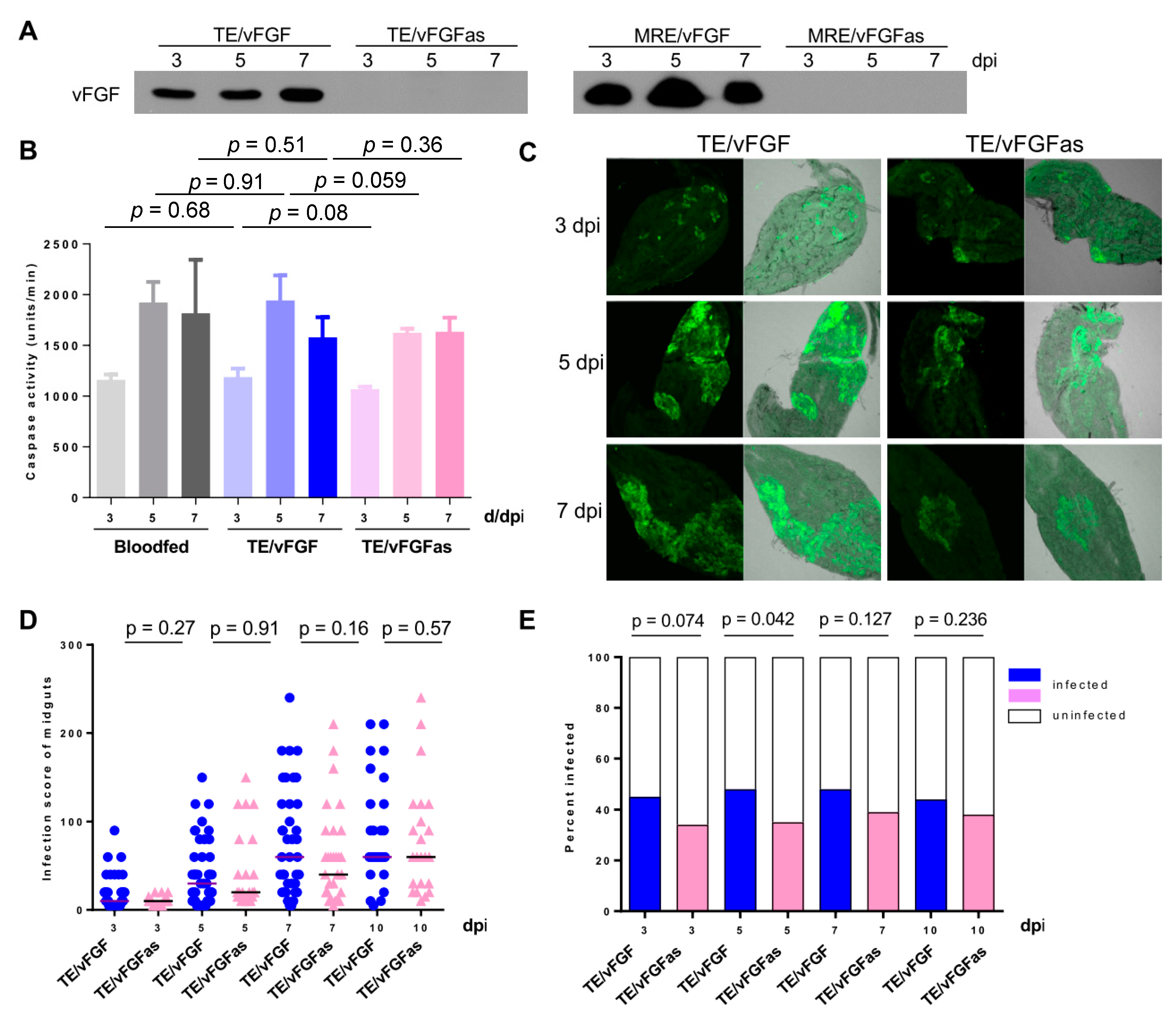
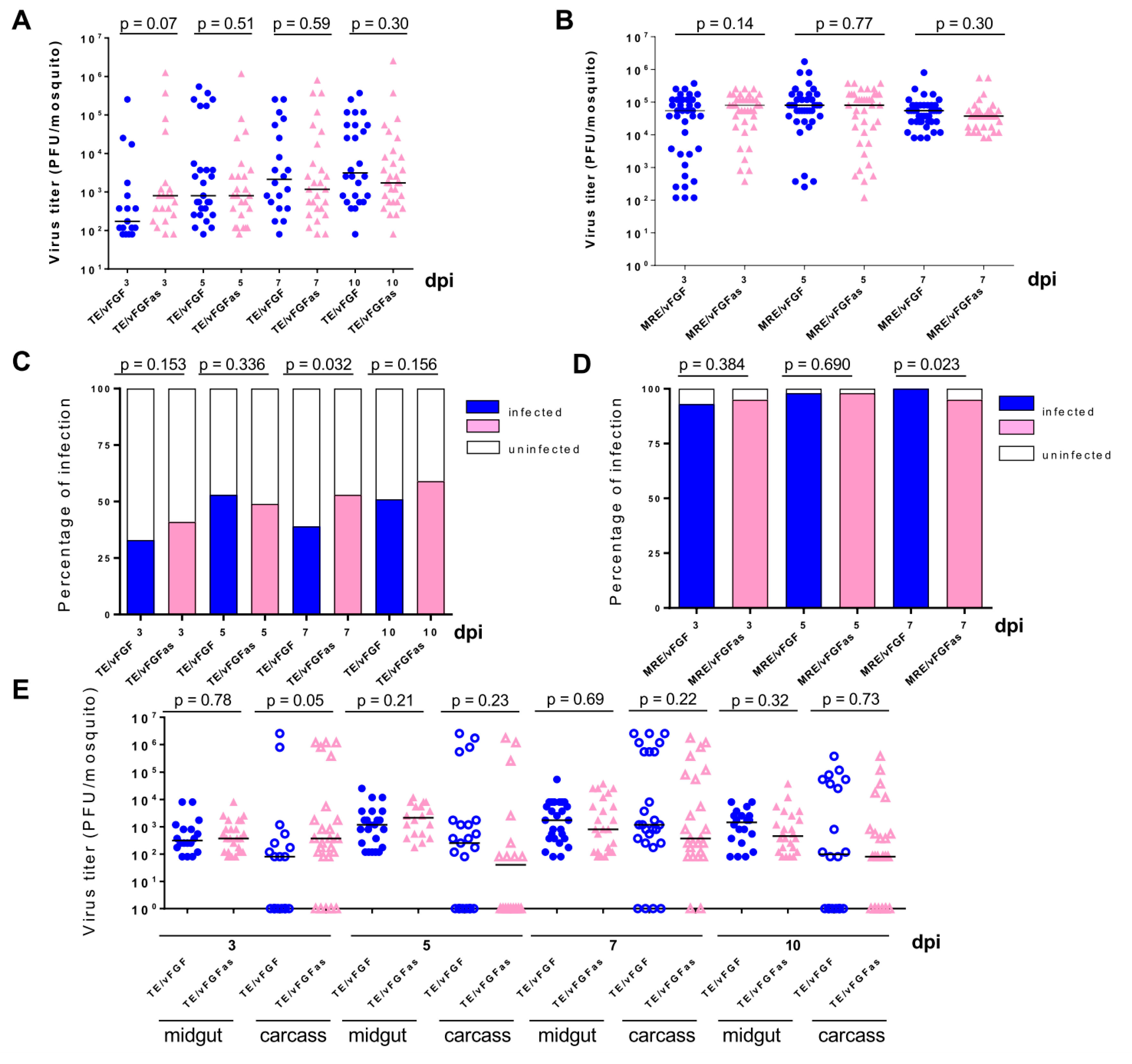
© 2020 by the authors. Licensee MDPI, Basel, Switzerland. This article is an open access article distributed under the terms and conditions of the Creative Commons Attribution (CC BY) license (http://creativecommons.org/licenses/by/4.0/).
Share and Cite
Wu, W.; Simmons, C.A.; Moffitt, J.; Clem, R.J.; Passarelli, A.L. Effects of Manipulating Fibroblast Growth Factor Expression on Sindbis Virus Replication In Vitro and in Aedes aegypti Mosquitoes. Viruses 2020, 12, 943. https://doi.org/10.3390/v12090943
Wu W, Simmons CA, Moffitt J, Clem RJ, Passarelli AL. Effects of Manipulating Fibroblast Growth Factor Expression on Sindbis Virus Replication In Vitro and in Aedes aegypti Mosquitoes. Viruses. 2020; 12(9):943. https://doi.org/10.3390/v12090943
Chicago/Turabian StyleWu, Wenbi, Cody A. Simmons, Jessica Moffitt, Rollie J. Clem, and A. Lorena Passarelli. 2020. "Effects of Manipulating Fibroblast Growth Factor Expression on Sindbis Virus Replication In Vitro and in Aedes aegypti Mosquitoes" Viruses 12, no. 9: 943. https://doi.org/10.3390/v12090943
APA StyleWu, W., Simmons, C. A., Moffitt, J., Clem, R. J., & Passarelli, A. L. (2020). Effects of Manipulating Fibroblast Growth Factor Expression on Sindbis Virus Replication In Vitro and in Aedes aegypti Mosquitoes. Viruses, 12(9), 943. https://doi.org/10.3390/v12090943







